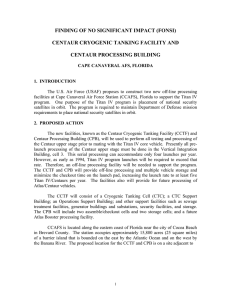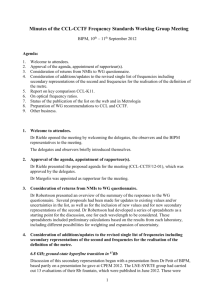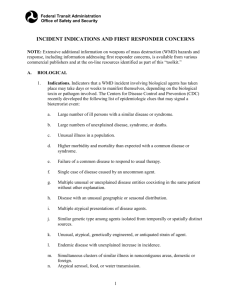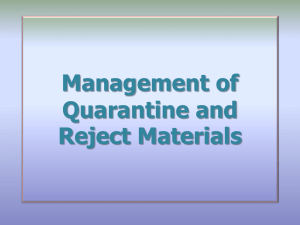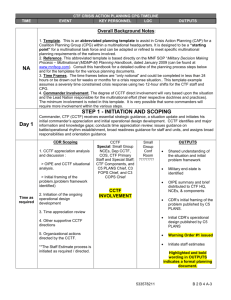Annex F - Nuclear, Biological, and Chemical (NBC) Operations
advertisement
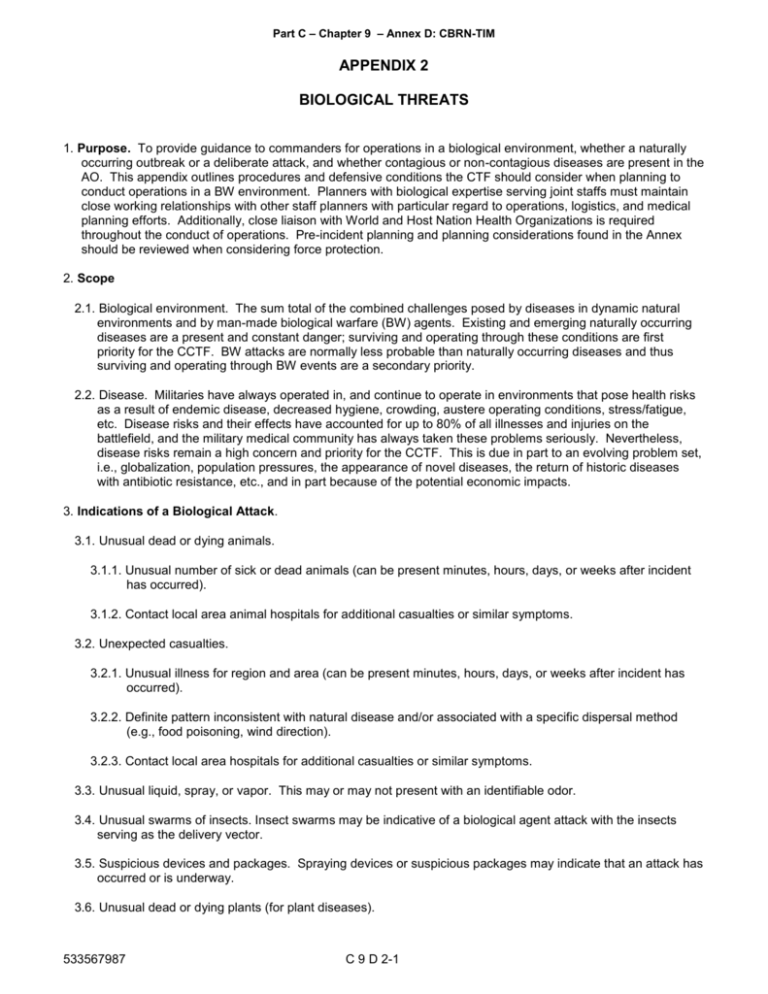
Part C – Chapter 9 – Annex D: CBRN-TIM APPENDIX 2 BIOLOGICAL THREATS 1. Purpose. To provide guidance to commanders for operations in a biological environment, whether a naturally occurring outbreak or a deliberate attack, and whether contagious or non-contagious diseases are present in the AO. This appendix outlines procedures and defensive conditions the CTF should consider when planning to conduct operations in a BW environment. Planners with biological expertise serving joint staffs must maintain close working relationships with other staff planners with particular regard to operations, logistics, and medical planning efforts. Additionally, close liaison with World and Host Nation Health Organizations is required throughout the conduct of operations. Pre-incident planning and planning considerations found in the Annex should be reviewed when considering force protection. 2. Scope 2.1. Biological environment. The sum total of the combined challenges posed by diseases in dynamic natural environments and by man-made biological warfare (BW) agents. Existing and emerging naturally occurring diseases are a present and constant danger; surviving and operating through these conditions are first priority for the CCTF. BW attacks are normally less probable than naturally occurring diseases and thus surviving and operating through BW events are a secondary priority. 2.2. Disease. Militaries have always operated in, and continue to operate in environments that pose health risks as a result of endemic disease, decreased hygiene, crowding, austere operating conditions, stress/fatigue, etc. Disease risks and their effects have accounted for up to 80% of all illnesses and injuries on the battlefield, and the military medical community has always taken these problems seriously. Nevertheless, disease risks remain a high concern and priority for the CCTF. This is due in part to an evolving problem set, i.e., globalization, population pressures, the appearance of novel diseases, the return of historic diseases with antibiotic resistance, etc., and in part because of the potential economic impacts. 3. Indications of a Biological Attack. 3.1. Unusual dead or dying animals. 3.1.1. Unusual number of sick or dead animals (can be present minutes, hours, days, or weeks after incident has occurred). 3.1.2. Contact local area animal hospitals for additional casualties or similar symptoms. 3.2. Unexpected casualties. 3.2.1. Unusual illness for region and area (can be present minutes, hours, days, or weeks after incident has occurred). 3.2.2. Definite pattern inconsistent with natural disease and/or associated with a specific dispersal method (e.g., food poisoning, wind direction). 3.2.3. Contact local area hospitals for additional casualties or similar symptoms. 3.3. Unusual liquid, spray, or vapor. This may or may not present with an identifiable odor. 3.4. Unusual swarms of insects. Insect swarms may be indicative of a biological agent attack with the insects serving as the delivery vector. 3.5. Suspicious devices and packages. Spraying devices or suspicious packages may indicate that an attack has occurred or is underway. 3.6. Unusual dead or dying plants (for plant diseases). 533567987 C 9 D 2-1 Part C – Chapter 9 – Annex D – Appendix 2 4. Mitigation 4.1. Prophylaxis. Medical actions to prevent the development of symptoms, consisting of two main types: 4.1.1. Chemical. Antibiotics, antivirals and antitoxins comprise this category; and 4.1.2. Vaccines. Generally, vaccines are administered prior to exposure. Relatively few vaccines exist against BW agents. 4.2. Physical Protection. Required capabilities to survive and operate in a biologically contaminated environment beyond those listed above. The CCTF should avoid operating in contaminated areas to the greatest extent possible. 4.2.1. Individual protection. Most biological agents are inhalation hazards; some are contact hazards and others are food/water-borne agents. Protective masks protect against most aerosolized agents. Mission-oriented protective posture (MOPP) suits are effective against most contact hazards. Selfcontained protective equipment, e.g., suits with battery-powered positive pressure purified air, will severely limit military operations, and are relatively scarce. Respirators and even surgical masks give some protection against biological agents, and have the advantage of minimal operational degradation, especially when worn for 12 duty hour shifts or longer. 4.2.2. Collective protection. The number and types of collective protection shelters that are available for rapid deployment is extremely limited. 4.2.3. Other Protective Measures. Additional protective measures include hand-washing, good field sanitation, prepackaged food and bottled water. 4.3. Active Defenses. It is normally expected that adversary Special Forces and/or agents will be used to deliver biological weapons due to the small quantities required to have operational impacts. Moreover, biological weapons can be released some distance from a target if the wind direction and related conditions can be accurately predicted. It is therefore more difficult to organize active defenses against biological weapon release. The principal effort involves security forces deployed around likely targets, with these forces intercepting anyone without a good reason/permission for being in the area. The CCTF should seek to maintain such defenses when the threat situation is uncertain or hostile. 4.4. Biological Weapon Elimination. Normally, countries do not know much about the biological weapons programs of their neighbors. It is therefore difficult to locate and strike those programs. Ground forces may be able to capture the area where biological weapons are stored, but even then it may be difficult to locate and eliminate those weapons. Nevertheless, the CCTF should examine potential biological weapon elimination options. 5. Response 5.1. Strategic Communications. The potential public impact of a biological event cannot be overstated. Therefore, an active Public Affairs posture is an absolute necessity, and must be an integral part of operational planning and execution. Public information, evacuation routes, and health education information must all form part of the strategic communications campaign, along with efforts to convince the adversary that biological weapon use is neither acceptable nor legitimate. 5.2. Care and Management of Casualties. Planning must determine the capabilities and capacities of treatment facilities in the AO and where projected cases exceed in-theatre treatment capacity, CCTF must be prepared to develop a logistics support plan to include replacement of casualties. 5.2.1. Treat in place. Medical planners must plan for long-term care and symptom-based intensive care treatment rather than surgery, which is the basis for most deployable military medical units. There is an on going debate about the ability of coalition forces to “evacuate and treat” its own disease casualties, and to assist in the movement of other disease casualties. The basis for this debate is the lack of clear and effective national or multinational policies to guide the movement of infected/infectious patients using military and civilian aircraft, and the movement of these patients across international borders. C 9 D 2-2 Part C – Chapter 9 – Annex D – Appendix 2 Currently, “treat in place” may be the commander’s only viable option. This is a major driver for medical planning in a biological event scenario. 5.2.2. CCTF should seek clear and effective policies from Strategic commanders outlining the obligation to provide medical support (to include a definition of acceptable standards of care) to civilians in the AO. 5.2. Quarantine and Restriction of Movement. CCTF must identify the contaminated area and take measures to prevent the spread of disease by restricting movement into and out of the affected area. These actions address diseases like anthrax which is not contagious but the spores persist once spread. Alternatively, for contagious diseases, the focus must be on the people exposed rather than the area. People exposed to a contagious or readily communicable disease should be quarantined, while people exposed to other diseases may still need to be quarantined because of potential psychological reactions. Because it is normally impossible to determine who has been exposed before they exhibit symptoms, a large number of people may need to be quarantined. Once established, quarantine areas or quarantined populations must be logistically supported, which will require large numbers of people and may require a decontamination process. Moreover, the CCTF may be called upon to enforce the quarantine or assist in enforcing it. Close co-ordination with Host Nation authorities will be required. This is particularly important in a contagious disease scenario. Quarantine of animals may be required with the spread of agricultural diseases, with the CCTF potentially also involved in such quarantine. 5.3. Biological/Toxin sampling. 5.6.1. To ensure the integrity of physiological samples, adherence to correct collection, handling and transporting procedures is essential. The quality of any analytical evaluation is directly related to the quality of the specimen and degree of post-collection degradation that occurs prior to testing. For attribution and sample integrity purposes, ensure a positive chain of custody is defined, established, and in place. 5.6.1. Requests for biological sampling will be directed by the CTF C3 in coordination with the CTF Surgeon. Requests will be coordinated with the medical community and CBRN detection assets. 5.6.1. Different agencies will perform the collection of samples depending upon the type of sample to be collected and the assets available to the CCTF. 5.6.1. Medical or Health Service Support (HSS) personnel, supported by CBRN detection personnel, will perform the collection of biomedical samples. 5.6.1. Environmental sampling not involving humans or animals will be conducted by CBRN detection personnel in accordance with service doctrine and unit standard operating procedures under the direction of the CCTF. 5.6.1. Sampling units will transfer samples to the CTF-designated CB transfer point for analysis or further retrograde to designated test and analysis sites for the MNF effort. 6. Recovery. 6.1. Restoration. Hazard mitigation and elimination activities may impact on-going and future military operations, as temporary or permanent loss of access to equipment and facilities may occur. The lack of international standards for decontamination may complicate the restoration process. If a contagious agricultural disease is spread, animals vulnerable to that disease may need to be destroyed and properly disposed of in large numbers, and the CCTF may be asked to assist in that process. 1.1. Disengagement. As with restoration, disengagement may be complicated following a biological event which may change the operational end-state. Close co-ordination between the strategic and operational levels will be required. Tabs Tab A: Biological Technical Considerations C 9 D 2-3 Part C – Chapter 9 – Annex D – Appendix 2 PAGE INTENTIONALLY LEFT BLANK C 9 D 2-4
